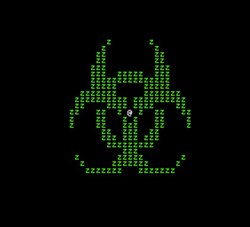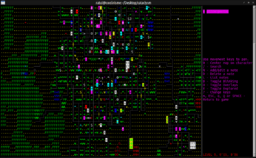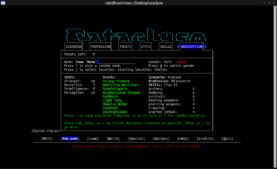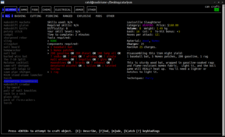Cataclysm: Dark Days Ahead
| Cataclysm: Dark Days Ahead | |
|---|---|
 | |
| Developer(s) | Kevin Granade |
| Platform(s) | Microsoft Windows, Linux, OS X |
| Release date(s) | 2013 |
| Genre(s) | Roguelike, survival horror |
| Mode(s) | Single-player |
| Display | ASCII with ncurses, Tiles with SDL |

Cataclysm: Dark Days Ahead is a survival horror roguelike video game. It is the open source continuation of Cataclysm, after the original developer released the source code under a Creative Commons licence on GitHub.[1] It was successfully crowdfunded on Kickstarter in 2013[2][3] with the goal of hiring a full-time developer. The latest version of the game is 0.C "Cooper" released on March 11, 2015.
Cataclysm: DDA provides true text based graphics based on Ncurses. A SDL version of the game which uses tiles is also available.
Plot
The game is set in near-future New England[4] after a catastrophic event killed most of the human population and spawned various monsters and hazards.
Development
Cataclysm: Dark Days Ahead is a fork of the original game Cataclysm.[5] The game is undergoing massive development and is apt to change quite a lot between releases. New releases are made roughly twice a year while up-to-the day development releases are available and the source code is freely available on the project's GitHub repository.[6]
Gameplay
Unlike most roguelikes, it has no goal: the player is free to explore the procedurally generated map, clear areas of monsters, work with NPCs, and build shelters and vehicles. The gameplay is mainly based on day-to-day survival, and the game tracks parameters like hunger, thirst, morale, illness and temperature which the player must manage to stay alive. There are several other things in the game such as NPC Quests and Secret Structures but as of Cataclysm: DDA 0.B "Brin" NPCs are disabled by default due to several technical difficulties.[7] However the player may still enable them if they wish. Like most roguelikes Cataclysm: DDA follows turn based gameplay.
World

The world is persistent between games. Starting a new character after the death of a previous character, the new game can be set in the same game world as the last.[8] The world has support for seasons and dynamic weather conditions and the season lengths can be modified during world generation.[6] A typical world has cities, towns, rivers, forests, bridges and other landmarks. Cities and towns generally have all the common establishments generally found in real world such as houses, departmental stores, malls, parking lots, swimming pools, hospitals, etc. Exotic locations such as Science Labs, Military installations, missile silos can be found in remote places throughout the whole world. Latest versions have support for experimental 3-D buildings.[9]
Character

Characters can be generated randomly or can be custom-built to suit player gameplay and preferences. Players choose from several available initial scenarios. The default scenario is 'Evacuee' in which the player starts from an evacuation center with few provisions. Choosing harder scenarios awards the player with points with which they can create more powerful characters. Like most roguelikes, the game allows players to initially choose from various professions and each professions have their own set of traits and skills. In character creation, positive traits can be chosen by consuming points, and stats like 'strength' and 'intelligence' and skills like 'archery' can also be increased through spending points. Negative traits earn the player more points to spend on positive traits, stats or skills. Characters can increase their skills gradually once in-game by practicing the respective skills or reading books obtained from various sources found within the cities or towns. The game also has a skill rust system by which skill levels decrease with time due to disuse.
The game has a menu which shows the current conditions such as Hunger, Thirst, Morale or any existing illness from which the character is suffering. In order to survive the character has to consume food and water regularly. The character also needs rest regularly otherwise the stats take a negative hit. This menu also shows the skill progression of the character.
Crafting

Unlike most roguelikes, Cataclysm: DDA focuses heavily on crafting with many basic necessities such as clothing and food being craftable from raw items that are found lying around the world. For crafting to be successful the player needs the necessary raw materials and equipment. The player also needs to learn the recipe of the object to be crafted which can be unlocked by reading books from libraries. Successful crafting leads to an increase of the corresponding skill. Craftable items are classified into Weapons, Ammo, Food, Chemicals, Armor and others with several subcategories in each of them. The crafting menu also allows the player to improve existing items.
Crafting can be hampered by player conditions such as low morale or other external game conditions like insufficient light or the presence of monsters nearby. The crafting menu can be accessed by pressing the '&' key during the game.
Construction

Cataclysm features an intricate construction menu where one can perform simple construction activities like boarding up a window, digging a pit to elaborate ones like building a reinforced concrete wall, stone wall, digging a well or creating basements. Like crafting, construction requires raw materials like brick, stones, or nails. Equipment required for construction can be either salvaged from cities or can be crafted via the crafting menu from additional raw materials.
Vehicles can be repaired or even constructed from scratch using the construction menu. Players are reported to have created vehicles of quite different sizes and capabilities - from small quad bikes with limited storage[10] to huge 'monstrosities'[11] with multiple engines, turrets, machine guns, chemical labs.
Farming
The player can farm land and grow grains, vegetables, berries and other shrubs (eg. cotton) provided that he finds the respective seeds. The final crop can be laid up for later use (though some food may perish), it can be eaten raw or can be used to prepare more elaborated products (eg. cooking oil, flour, spirits, vinegar, sealed food). Farming season usually extends from late spring to early autumn and depends on external temperature. Every plant type has different growing rates and growth can be accelerated using commercial or home-made fertilizers. Final output depends on character survival skill: the higher the skill, the higher the yield of every single plant. Once harvested all plants are considered "dead" and leave straw (grains) or withered plants and some seeds.
See also
References
- ↑ "Cataclysm / LICENSE".
- ↑ "Cataclysm: Dark Days Ahead - Dedicated Developer".
- ↑ "Multipocalyptic Roguelike Cataclysm: Dark Days Ahead Turns To Kickstarter".
- ↑ "C:DDA Design Outline".
- ↑ "Cataclysm - RogueBasin". www.roguebasin.com. Retrieved 2015-11-25.
- 1 2 "CleverRaven/Cataclysm-DDA". GitHub. Retrieved 2015-11-25.
- ↑ "NPC - The Cataclysm: Dark Days Ahead Wiki". Wiki.cataclysmdda.com. 2016-08-29. Retrieved 2016-09-20.
- ↑ "Whales/Cataclysm". GitHub. Retrieved 2015-11-25.
- ↑ "CleverRaven/Cataclysm-DDA". GitHub. Retrieved 2015-11-25.
- ↑ "I tried building a smaller vehicle instead of a montrosity. • /r/cataclysmdda". reddit. Retrieved 2015-11-25.
- ↑ "Vehicle Show and Tell". smf.cataclysmdda.com. Retrieved 2015-11-25.